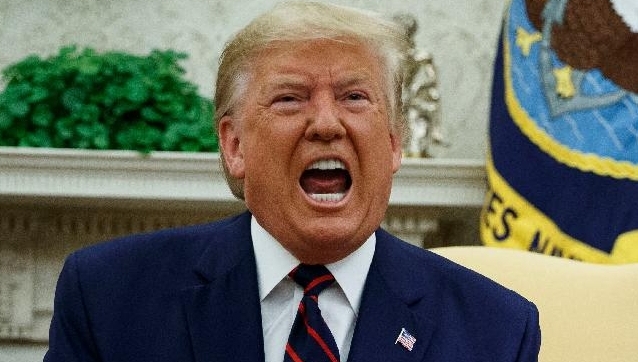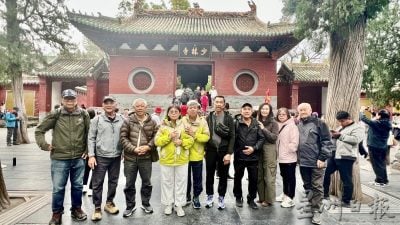By Michael Tai
Overseas Chinese—Chinese living outside of Mainland China, Hong Kong, Macau and Taiwan—are not necessarily pro-Beijing; many are traditionally pro-Western but the Trump administration has pushed them into Beijing's arms. The Chinese diaspora numbers around 40 million; the largest communities are found in Thailand (10 million), Malaysia (6.65 million), Indonesia (7.2 million) and the United States (2.5 million) but Chinese settle in virtually every corner of the world; over a million now work in Africa and there's even an authentic Chinese restaurant in downtown Kabul.
They go forth not in search of adventure but livelihood. Many go as manual laborers but where opportunities arise, they open restaurants and shops purveying groceries, sundry goods and services ranging from the mending of shoes and bicycles to mobile phones and automobiles.
Thanks to a Confucian ethic where overcoming adversity is seen as a cardinal virtue, they survive and prosper through sheer hard work and perseverance. But they also have a penchant for business as Welshman John Davis who lived in the Malay Archipelago for twenty years observed in 1834:
[The Chinese] are keen, enterprising traders, extremely expert in their dealings, and understand the nature of trade of those countries in which they have settled perhaps better than any other people; they seem to have very accurate information and receive it very quickly too. Those who have obtained a high reputation are extremely tenacious of it, and they are very punctual in their dealings. I do not think they are exceeded by the natives of any country as a commercial people, including European countries …
Robert Kuok calls them "the most amazing economic ants on earth" but success invites admiration as well as envy, and not unlike the Jews, they often suffer discrimination, violence and expulsion. Chinese were massacred in Indonesia (during Dutch colonial rule as well as post-independence), the Philippines and other parts of Southeast Asia while the Chinese Exclusion Act passed by the US Congress in 1882 barred Chinese from the United States and declared Chinese immigrants ineligible for citizenship. As late as the 1960s, Chinese in America were not allowed to own land and property while miscegenation laws prohibited inter-racial marriages.
In the postwar period, many overseas Chinese were effectively stateless. Seeking to restart relations with Southeast Asian neighbors in the 1970s (in light of foreseeable US withdrawal from Vietnam), Beijing moved to resolve concerns by Southeast Asian governments over the status and, more importantly, the loyalty of the Chinese under their rule but in the throes of the Cultural Revolution and with a per capita GDP of $130, China was hardly in a position to welcome and reintegrate millions of returnees. Beijing decided to close the door to citizenship to overseas Chinese who were now encouraged to put down permanent roots and become citizens of their host countries.
Suffering frequent discrimination, overseas Chinese are pleased to see China prosper. Rather than orphans, they now feel like offspring of a millionaire. Instead of the "sick man of Asia," China became the factory of the world and the global growth engine. An impressive space program and leadership in sectors such as solar panels, nuclear power generation, hi-speed rail, electric vehicles (entire municipal bus fleets run on electricity) and mobile payments, not to mention free-spending Chinese tourists (who spent $130 billion overseas in 2018) together with Chinese real estate and infrastructure investments around the world have all boosted Chinese prestige. In 2017, the World Bank ranked China as an upper-middle income country with a middle class, by some estimates, of 400 million people—equivalent to the European and American middle classes combined.
Celebrating the revival in the fortunes of their cultural homeland, overseas Chinese are angered by the President Trump's attacks on China. They see an America bent on obstructing and stigmatizing China; the trade war, the arrest of Huawei CFO Meng Wanzhou, and Trump's calling the coronavirus the Wuhan virus and Chinese virus (had the pandemic begun in Jerusalem, no one in Washington would dare call it the Jerusalem or Jewish virus) leave them in no doubt that Trump and his close advisors are white supremacist demagogues.
The recent wave of racist attacks against Asians across America and Europe as the coronavirus spreads deepens their sense of alienation and reminds them once again that they will never be accepted as equals in Western society. China bashing and the steady drumbeat from Washington at this time serves only to create a groundswell of support for Beijing even among those normally disinterested in international politics. They see US Secretary of State Mike Pompeo's push to blame China for the pandemic's spread by including "Wuhan virus" language in a G7 joint statement and its rejection by G7 foreign ministers as another sign of decay in American virtue and leadership. In trying to control the narrative, Washington overplayed its hand and pushed Chinese around the world deeper into Beijing's arms, and Trump may yet pay dearly for distressing Asian American voters.
Trump's anti-Chinese tirades may be motivated by a desire to draw attention away from his policy missteps and to bolster his chances of re-election in November. Realizing his mistake, Trump toned down his xenophobia, calling the US to "protect our Asian American community" but has since resumed his polemic. There are more than 20 million Asian Americans but thanks to language barriers and voter suppression tactics, their turnout at the ballot box has traditionally been low (49% compared to 64% of white Americans). This time things may be different. The pandemic brought latent racism out into the open, galvanizing Asian Americans to come out and vote for the safety of their families.
Kartik Jayaram, Omid Kassiri, and Sun Irene, "The Closest Look yet at Chinese Economic Engagement in Africa" (McKinsey and Company, June 2017).
Victor Purcell, The Chinese in Malaya (Oxford Univ. Press, 1948), 52.
A.R.T. Kemasang, "The 1740 Massacre of Chinese in Java: Curtain Raiser for the Dutch Plantation Economy," Critical Asian Studies 14, no. 1 (1982): 61–71; Soutik Biswas, US Knew about Indonesia 1960s Massacres, BBC News, October 17, 2017, sec. Asia.
José Eugenic Borao, "The Massacre of 1603 Chinese Perception of the Spanish in the Philippines," Itinerario 22, no. 1 (1998): 22–40.
Tunku Abdul Rahman, May 13: Before and After (Kuala Lumpur: Utusan Melayu Press, 1969); Leon Comber, 13 May 1969: The Darkest Day in Malaysian History (Singapore: Marshall Cavendish, 2009); Tashny Sukumaran, Malaysia's May 13 Racial Riots: 50 Years on, They Couldn't Happen Again, Could They? South China Morning Post, May 13, 2019, sec. This Week in Asia.
Chinese GDP per capita in 1972.
Wang Gungwu, "The Question of the 'Overseas Chinese,'" Southeast Asian Affairs, 1976, 101–10.
Hu Zhe 胡哲, Chinese Tourists Spend $130 Bln Overseas in 2018, China Daily, August 5, 2019.
Liz Alderman, Europe's Middle Class Is Shrinking. Spain Bears Much of the Pain, The New York Times, February 14, 2019.
Trump Says We Must 'Protect Asian Americans' but Has No Answer on How to Stop Hate Crimes, accessed April 12, 2020.
Aastha Uprety, 5 Ways to Increase Asian American Voter Turnout, Center for American Progress, May 7, 2018.
(Dr Michael Tai is a Fellow of the Royal Asiatic Society and the author of China and her Neighbours: Asian Diplomacy from Ancient History to the Present Day and US-China Relations in the 21st Century: A Question of Trust.)

ADVERTISEMENT
ADVERTISEMENT


































